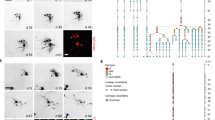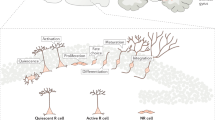Abstract
Neural stem cells are present both in the developing nervous system and in the adult nervous system of all mammals, including humans. Little is known, however, about the extent to which stem cells in adults can give rise to new neurons. We used immunocytochemistry, electron microscopy, fluorescence microscopy (FM imaging) and electrophysiology to demonstrate that progeny of adult rat neural stem cells, when co-cultured with primary neurons and astrocytes from neonatal hippocampus, develop into electrically active neurons and integrate into neuronal networks with functional synaptic transmission. We also found that functional neurogenesis from adult stem cells is possible in co-culture with astrocytes from neonatal and adult hippocampus. These studies show that neural stem cells derived from adult tissues, like those derived from embryonic tissues, retain the potential to differentiate into functional neurons with essential properties of mature CNS neurons.
This is a preview of subscription content, access via your institution
Access options
Subscribe to this journal
Receive 12 print issues and online access
$209.00 per year
only $17.42 per issue
Buy this article
- Purchase on Springer Link
- Instant access to full article PDF
Prices may be subject to local taxes which are calculated during checkout






Similar content being viewed by others
References
Gage, F. H. Mammalian neural stem cells. Science 287, 1433–1438 (2000).
Temple, S. The development of neural stem cells. Nature 414, 112–117 (2001).
Weissman, I. L., Anderson, D. J. & Gage, F. Stem and progenitor cells: origins, phenotypes, lineage commitments, and transdifferentiations. Annu. Rev. Cell Dev. Biol. 17, 387–403 (2001).
Altman, J. & Das, G. D. Autoradiographic and histological evidence of postnatal neurogenesis in rats. J. Comp. Neurol. 124, 319–335 (1965).
Kaplan, M. S. & Hinds, J. W. Neurogenesis in the adult rat: electron microscopic analysis of light radioautographs. Science 197, 1092–1094 (1977).
van Praag, H. et al. Functional neurogenesis in the adult hippocampus. Nature 415, 1030–1034 (2002).
Reynolds, B. A. & Weiss, S. Generation of neurons and astrocytes from isolated cells of the adult mammalian central nervous system. Science 255, 1707–1710 (1992).
Lois, C. & Alvarez-Buylla, A. Proliferating subventricular zone cells in the adult mammalian forebrain can differentiate into neurons and glia. Proc. Natl. Acad. Sci. USA 90, 2074–2077 (1993).
Palmer, T. D., Markakis, E. A., Willhoite, A. R., Safar, F. & Gage, F.H. Fibroblast growth factor-2 activates a latent neurogenic program in neural stem cells from diverse regions of the adult CNS. J. Neurosci. 19, 8487–8497 (1999).
Brazelton, T. R., Rossi, F. M., Keshet, G. I. & Blau, H. M. From marrow to brain: expression of neuronal phenotypes in adult mice. Science 290, 1775–1779 (2000).
Mezey, E., Chandross, K. J., Harta, G., Maki, R. A. & McKercher, S. R. Turning blood into brain: cells bearing neuronal antigens generated in vivo from bone marrow. Science 290, 1779–1782 (2000).
Kondo, T. & Raff, M. Oligodendrocyte precursor cells reprogrammed to become multipotential CNS stem cells. Science 289, 1754–1757 (2000).
Roy, N. S. et al. In vitro neurogenesis by progenitor cells isolated from the adult human hippocampus. Nat. Med. 6, 271–277 (2000).
Woodbury, D., Schwarz, E. J., Prockop, D. J. & Black, I. B. Adult rat and human bone marrow stromal cells differentiate into neurons. J. Neurosci. Res. 61, 364–370 (2000).
Toma, J.G. et al. Isolation of multipotent adult stem cells from the dermis of mammalian skin. Nat. Cell Biol. 3, 778–784 (2001).
Toda, H., Takahashi, J., Mizoguchi, A., Koyano, K. & Hashimoto, N. Neurons generated from adult rat hippocampal stem cells form functional glutamatergic and GABAergic synapses in vitro. Exp. Neurol. 165, 66–76 (2000).
Finley, M. F., Kulkarni, N. & Huettner, J. E. Synapse formation and establishment of neuronal polarity by P19 embryonic carcinoma cells and embryonic stem cells. J. Neurosci. 16, 1056–1065 (1996).
Vicario-Abejon, C., Collin, C., Tsoulfas, P. & McKay, R. D. Hippocampal stem cells differentiate into excitatory and inhibitory neurons. Eur. J. Neurosci. 12, 677–688 (2000).
Kandel, E. R., Schwartz, J. H. & Jessell, T. M. Principles of Neural Science (McGraw-Hill, New York, 2000).
Jessell, T. M. & Sanes, J. R. Development. The decade of the developing brain. Curr. Opin. Neurobiol. 10, 599–611 (2000).
Ullian, E. M., Sapperstein, S. K., Christopherson, K. S. & Barres, B. A. Control of synapse number by glia. Science 291, 657–661(2001).
Blondel, O. et al. A glia-derived signal regulating neuronal differentiation. J. Neurosci. 20, 8012–8020 (2000).
Palmer, T. D., Takahashi, J. & Gage, F. H. The adult rat hippocampus contains primordial neural stem cells. Mol. Cell. Neurosci. 8, 389–404 (1997).
Takahashi, J., Palmer, T. D. & Gage, F. H. Retinoic acid and neurotrophins collaborate to regulate neurogenesis in adult-derived neural stem cell cultures. J. Neurobiol. 38, 65–81 (1999).
Suhonen, J. O., Peterson, D. A., Ray, J. & Gage, F. H. Differentiation of adult hippocampus-derived progenitors into olfactory neurons in vivo. Nature 383, 624–627 (1996).
Song, H-J., Stevens, C. F. & Gage, F. H. Astroglia induce neurogenesis from adult stem cells. Nature (in press).
Goslin, K., Asmussen, H. & Banker, G. in Culturing Nerve Cells (eds. Banker, G. & and Golsin, K.) 339–370 (MIT Press, Cambridge, Massachusetts, 1998).
Sudhof, T. C. et al. Synapsins: mosaics of shared and individual domains in a family of synaptic vesicle phosphoproteins. Science 245, 1474–1480 (1989).
Bekkers, J. M. & Stevens, C. F. Excitatory and inhibitory autaptic currents in isolated hippocampal neurons maintained in cell culture. Proc. Natl. Acad. Sci. USA 88, 7834–7838 (1991).
Zaheer, A., Zhong, W., Uc, E. Y., Moser, D. R. & Lim, R. Expression of mRNAs of multiple growth factors and receptors by astrocytes and glioma cells: detection with reverse transcription–polymerase chain reaction. Cell. Mol. Neurobiol. 15, 221–237 (1995).
Nicholls, J. G., Martin, A. R. & Wallace, B. G. From Neuron To Brain: A Cellular and Molecular Approach to the Function of the Nervous System 3rd edn. 149–152 (Sinauer, Sunderland, Massachusetts, 1992).
Taupin, P. et al., FGF-2–responsive neural stem cell proliferation requires CCg, a novel autocrine/paracrine cofactor. Neuron 28, 385–397 (2000).
Clarke, D. & Frisen, J. Differentiation potential of adult stem cells. Curr. Opin. Genet. Dev. 11, 575–580 (2001).
Ryder, E. F., Snyder, E. Y. & Cepko, C. L. Establishment and characterization of multipotent neural cell lines using retrovirus vector–mediated oncogene transfer. J. Neurobiol. 21, 356–375 (1990).
Sucher, N. J. et al. Expression of endogenous NMDAR1 transcripts without receptor protein suggests post-transcriptional control in PC12 cells. J. Biol. Chem. 268, 22299–22304 (1993).
Hales, T. G. & Tyndale, R. F. Few cell lines with GABAA mRNAs have functional receptors. J. Neurosci. 14, 5429–5436 (1994).
Ye, G., Song Liu, X., Pasternak, J. F. & Trommer, B. L. Maturation of glutamatergic neurotransmission in dentate gyrus granule cells. Brain Res. Dev. Brain Res. 124, 33–42 (2000).
Mehler, M. F., Rozental, R., Dougherty, M., Spray, D. C. & Kessler, J. A. Cytokine regulation of neuronal differentiation of hippocampal progenitor cells. Nature 362, 62–65 (1993).
Sah, D. W., Ray, J. & Gage, F. H. Regulation of voltage- and ligand-gated currents in rat hippocampal progenitor cells in vitro. J. Neurobiol. 32, 95–110 (1997).
Schubert, D. et al. Clonal cell lines from the rat central nervous system. Nature 249, 224–227 (1974).
Bekkers, J. M. & Stevens, C. F. NMDA and non-NMDA receptors are co-localized at individual excitatory synapses in cultured rat hippocampus. Nature 341, 230–233 (1989).
Auerbach, J. M., Eiden, M.V. & McKay, R. D. Transplanted CNS stem cells form functional synapses in vivo. Eur. J. Neurosci. 12, 1696–1704 (2000).
Mauch, D. H. et al. CNS synaptogenesis promoted by glia-derived cholesterol. Science 294, 1354–1357 (2001).
Haydon, P. G. Glia: listening and talking to the synapse. Nat. Rev. Neurosci. 2, 185–193 (2001).
Fitzsimonds, R. M., Song, H. J. & Poo, M. M. Propagation of activity-dependent synaptic depression in simple neural networks. Nature 388, 439–448 (1997).
Palmer, T. D., Thompson, A. R. & Miller, A. D. Production of human factor IX in animals by genetically modified skin fibroblasts: potential therapy for hemophilia B. Blood 73, 438–445 (1989).
Schwartz, J. P. & Wilson, D. J. Preparation and characterization of type 1 astrocytes cultured from adult rat cortex, cerebellum, and striatum. Glia 5, 75–80 (1992).
Nobel, M. & Mayer-Proschel, M. in Culturing Nerve Cells (eds. Banker, G. & Goslin, K.) 499–544 (MIT Press, Cambridge, Massachusetts, 1998).
Schikorski, T. & Stevens, C. F. Morphological correlates of functionally defined synaptic vesicle populations. Nat. Neurosci. 4, 391–395 (2001).
Murthy, V. N., Sejnowski, T. J. & Stevens, C. F. Heterogeneous release properties of visualized individual hippocampal synapses. Neuron 18, 599–612 (1999).
Acknowledgements
We would like to thank R. Jacobs for help on EM studies, Y. Zhu for FM4-64 studies and M. Gage and J. Sullivan for comments. This work is supported by the Howard Hughes Medical Institute, National Institutes of Health, Christopher Reeve Paralysis Foundation, National Institues of Aging, the Michael J. Fox Foundation, Project ALS and the Lookout Fund. C. F. S. is an investigator and H-j. S. is a postdoctoral associate of the Howard Hughes Medical Institute.
Author information
Authors and Affiliations
Corresponding authors
Ethics declarations
Competing interests
The authors declare no competing financial interests.
Supplementary information
Rights and permissions
About this article
Cite this article
Song, Hj., Stevens, C. & Gage, F. Neural stem cells from adult hippocampus develop essential properties of functional CNS neurons. Nat Neurosci 5, 438–445 (2002). https://doi.org/10.1038/nn844
Received:
Accepted:
Published:
Issue Date:
DOI: https://doi.org/10.1038/nn844
This article is cited by
-
Photoactivation of TGFβ/SMAD signaling pathway ameliorates adult hippocampal neurogenesis in Alzheimer’s disease model
Stem Cell Research & Therapy (2021)
-
Role of adult hippocampal neurogenesis in the antidepressant actions of lactate
Molecular Psychiatry (2021)
-
Dissecting transcriptomic signatures of neuronal differentiation and maturation using iPSCs
Nature Communications (2020)
-
Persistent Lin28 Expression Impairs Neurite Outgrowth and Cognitive Function in the Developing Mouse Neocortex
Molecular Neurobiology (2019)
-
From cord to caudate: characterizing umbilical cord blood stem cells and their paracrine interactions with the injured brain
Pediatric Research (2018)



